Connect With Us
Blogs
Blog
How to Deal With Infected Toenails
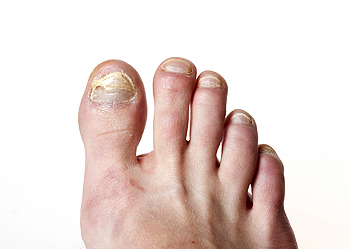
A toenail infection is often the result of a fungus growing on or under the nail. This turns the toenail a yellow or brownish color, causes it to thicken and crumble, and possibly separate the nail from the skin beneath it. Fungi grow best in moist, warm settings, such as gym locker rooms, swimming pool changing areas, and wet or moist socks and shoes. Prevention from a toenail fungal infection consists of keeping your feet clean and dry and your toenails trimmed properly. Wearing protective shoes or flip flops in areas where the fungus might be spread and using antifungal sprays in your shoes are other ways to protect your toes. Treatment of a toenail fungus involves taking antifungal medication, use of antifungal paints, and in some cases, removal of the nail. If you have a toenail infection that persists or becomes painful, please see a podiatrist for advanced treatment options.
For more information about treatment, contact Dr. Michael D. Garvin of Florida. Our doctor can provide the care you need to keep you pain-free and on your feet.
Toenail Fungus Treatment
Toenail fungus is a condition that affects many people and can be especially hard to get rid of. Fortunately, there are several methods to go about treating and avoiding it.
Antifungals & Deterrence
Oral antifungal medicine has been shown to be effective in many cases. It is important to consult with a podiatrist to determine the proper regiment for you, or potentially explore other options.
Applying foot powder on the feet and shoes helps keep the feet free of moisture and sweat.
Sandals or open toed shoes – Wearing these will allow air movement and help keep feet dry. They also expose your feet to light, which fungus cannot tolerate. Socks with moisture wicking material also help as well.
If you have any questions please feel free to contact our offices located in Port St. Lucie, FL . We offer the newest diagnostic tools and technology to treat your foot and ankle needs.
Iselin Disease
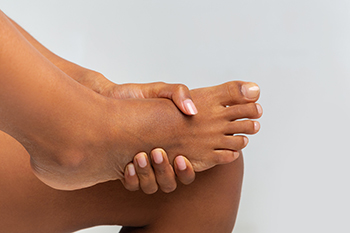
Iselin disease is an overuse injury resulting from repetitive pressure or tension on the growth center at the base of the 5th metatarsal. Running and jumping can put a great amount of pressure on the forefoot. This disease affects children and usually resolves itself once the growth plate fuses, which generally occurs around age 12 for girls and 14 for boys. It cannot occur in adults because the growth plate closes over and turns into the bone with skeletal maturity at approximately 16 years of age. If your child has foot pain and you think it might be Iselin disease, consult with a podiatrist for proper management of discomfort associated with this condition. A pediatric immobilization brace may be used to offload the growth plate and allow for healing so that your child may maintain their activity level.
Some foot conditions may require additional professional care. If you have any concerns, contact Dr. Michael D. Garvin of Florida. Our doctor can provide the care you need to keep you pain-free and on your feet.
Rare Foot Conditions
The majority of foot conditions are common and can be treated by a podiatrist. Standard diagnostic procedures are generally used to identify specific conditions and treatment can be rendered. A podiatrist also treats rare foot conditions which can be difficult to diagnose and may need extra attention and care.
There are many rare foot conditions that can affect children. Some of these can include:
- Freiberg’s disease
- Kohler’s disease
- Maffucci syndrome
Freiberg’s disease - This can be seen as a deterioration and flattening of a metatarsal bone that exists in the ball of the foot. It typically affects pre-teen and teenage girls, but can affect anyone at any age. Symptoms that can accompany this can be swelling, stiffness, and the patient may limp.
Kohler’s disease - This often targets the bone in the arch of the foot and affects younger boys. It can lead to an interruption of the blood supply which ultimately can lead to bone deterioration. The patient may limp or experience tenderness, swelling, and redness.
Maffucci syndrome - This affects the long bones in a child’s foot leading to the development of abnormal bone lesions. They are benign growths and typically develop in early childhood and the bones may be susceptible to breaking.
A podiatrist can properly diagnose and treat all types of rare foot conditions. If your child is affected by any of these symptoms or conditions, please don’t hesitate to call our office so the correct treatment method can begin.
If you have any questions please feel free to contact our offices located in Port St. Lucie, FL . We offer the newest diagnostic tools and technology to treat your foot and ankle needs.
Study Finds Link Between Weight and Level of Foot Pain
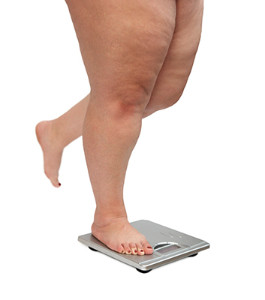 According to findings presented at the American College of Rheumatology Annual Meeting, patients with higher weights are more susceptible to foot pain. Instructor of Medicine Alyssa B. Dufour of Harvard Medical School and her colleagues studied 28 different measures over 57 years to identify the trajectories of weight in the Framingham Foot Study. After five such trajectories were established, patterns began to develop that showed a correlation between higher weight over time and higher levels of foot pain.
According to findings presented at the American College of Rheumatology Annual Meeting, patients with higher weights are more susceptible to foot pain. Instructor of Medicine Alyssa B. Dufour of Harvard Medical School and her colleagues studied 28 different measures over 57 years to identify the trajectories of weight in the Framingham Foot Study. After five such trajectories were established, patterns began to develop that showed a correlation between higher weight over time and higher levels of foot pain.
Obesity has become very problematic at this point in time and can have extremely negative effects on the feet. If you’re an obese individual and are concerned about your feet, contact Dr. Michael D. Garvin from Florida. Our doctor can provide the care you need to keep you pain-free and on your feet.
Obesity and Your Feet
Since your feet are what support your entire weight when standing, any additional weight can result in pain and swelling. Being overweight is one of the main contributors to foot complications.
Problems & Complications
Extra Weight – Even putting on just a few extra pounds could create serious complications for your feet. As your weight increases, your balance and body will shift, creating new stresses on your feet. This uneven weight distribution can cause pain, even while doing the simplest tasks, such as walking.
Diabetes – People who are overweight are at serious risk of developing type-2 diabetes, which has a drastic impact on the health of your feet. As you get older, your diabetes might worsen, which could lead to loss of feeling in your feet, sores, and bruises. You could also become more prone to various infections.
Plantar fasciitis – Pressure and stress that is placed on muscles, joints, and tendons can trigger plantar fasciitis, which is an inflammation of tissue that forms along the bottom of the foot.
If you have any questions please feel free to contact our offices located in Port St. Lucie, FL . We offer the newest diagnostic and treatment technologies for all your foot and ankle needs.
Preventing Poor Blood Circulation
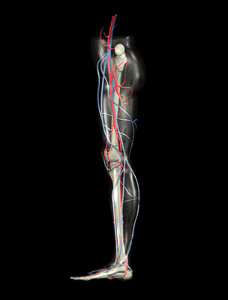 If your feet feel cold, especially during these winter months, it is because it is your body’s natural response for conserving heat when it is too cold. Your body “tries to maintain its internal temperature by constricting small blood vessels under the surface of the skin. This allows more blood to move deeper in the body, so your core stays warm.” However, this causes your body’s extremities, like the feet, to receive poor blood circulation. When taking care of your cold feet, try to wear warm, breathable socks that help wick away moisture. Opt for wool in place of cotton. Other methods include warming your feet up in warm water, drinking hot liquids, moving around to get your blood circulation going, and investing in shoe inserts to help insulate the insides of your shoes.
If your feet feel cold, especially during these winter months, it is because it is your body’s natural response for conserving heat when it is too cold. Your body “tries to maintain its internal temperature by constricting small blood vessels under the surface of the skin. This allows more blood to move deeper in the body, so your core stays warm.” However, this causes your body’s extremities, like the feet, to receive poor blood circulation. When taking care of your cold feet, try to wear warm, breathable socks that help wick away moisture. Opt for wool in place of cotton. Other methods include warming your feet up in warm water, drinking hot liquids, moving around to get your blood circulation going, and investing in shoe inserts to help insulate the insides of your shoes.
Poor circulation is a serious condition and needs immediate medical attention. If you have any concerns with poor circulation in your feet contact Dr. Michael D. Garvin of Florida. Our doctor will treat your foot and ankle needs.
Poor Circulation in the Feet
Poor blood circulation in the feet and legs is can be caused by peripheral artery disease (PAD), which is the result of a buildup of plaque in the arteries.
Plaque buildup or atherosclerosis results from excess calcium and cholesterol in the bloodstream. This can restrict the amount of blood which can flow through the arteries. Poor blood circulation in the feet and legs are sometimes caused by inflammation in the blood vessels, known as vasculitis.
Causes
Lack of oxygen and oxygen from poor blood circulation restricts muscle growth and development. It can also cause:
- Muscle pain, stiffness, or weakness
- Numbness or cramping in the legs
- Skin discoloration
- Slower nail & hair growth
- Erectile dysfunction
Those who have diabetes or smoke are at greatest risk for poor circulation, as are those who are over 50. If you have poor circulation in the feet and legs it may be caused by PAD and is important to make changes to your lifestyle in order to reduce risk of getting a heart attack or stroke. Exercise and maintaining a healthy lifestyle will dramatically improve conditions.
As always, see a podiatrist as he or she will assist in finding a regimen that suits you. A podiatrist can also prescribe you any needed medication.
If you have any questions please feel free to contact our offices located in Port St. Lucie, FL . We offer the newest diagnostic and treatment technologies for all your foot and ankle needs.
The Effects Obesity Has On the Feet
 It’s important to maintain proper foot care, and added weight can result in the development of numerous foot conditions. Being overweight may limit the type of exercise that is needed for correct body care, and the feet may be negatively affected. Edema, which is often referred to as swollen ankles, is a common side effect the feet may endure as a result of extra weight. The feet will be among the many parts of the body that will be positively affected after losing weight, which can include better blood circulation and more manageable edema. Choosing shoes with maximum support, which may typically consist of a sturdy sole, can aid the foot in achieving optimum comfort. Please schedule a consultation with a podiatrist to acquire additional information of how obesity can affect the feet
It’s important to maintain proper foot care, and added weight can result in the development of numerous foot conditions. Being overweight may limit the type of exercise that is needed for correct body care, and the feet may be negatively affected. Edema, which is often referred to as swollen ankles, is a common side effect the feet may endure as a result of extra weight. The feet will be among the many parts of the body that will be positively affected after losing weight, which can include better blood circulation and more manageable edema. Choosing shoes with maximum support, which may typically consist of a sturdy sole, can aid the foot in achieving optimum comfort. Please schedule a consultation with a podiatrist to acquire additional information of how obesity can affect the feet
The more you weigh, the harder your feet must work to support your body. If you’re an obese individual and are concerned about your feet, contact Dr. Michael D. Garvin from Florida. Our doctor can provide the care you need to keep you pain-free and on your feet.
Obesity and Your Feet
People who are overweight are putting more pressure on their ankles, knees, and hips as well as their feet. This unfortunately can lead to variety of different issues.
Problems & Complications Stemming from Obesity
- When the body is overweight, it tries to compensate by changing the way that it moves. An obese person may lean forward and put extra weight on the wrong part of the foot. This puts unnecessary stress on the feet.
- Obese people are also more likely to develop type II diabetes which is a condition that causes a lot of foot problems. People with diabetes often don’t feel the cuts and sores that they may have on their feet, which can lead to more complicated and severe issues.
- Plantar fasciitis is another foot condition that can be caused by obesity. Plantar fasciitis is an inflammation of the tissue along the bottom of the foot, which causes pain and stiffness while walking and climbing stairs.
If you have any questions, please feel free to contact our offices located in Port St. Lucie, FL . We offer the newest diagnostic and treatment technologies for all your foot care needs.
The Importance of Checking Your Feet Daily
 Foot health is always important, but its importance increases with age. Foot care becomes increasingly crucial for older adults. Performing daily foot exams is essential in making sure your feet are healthy, especially if you have diabetes. These daily exams can be easily accomplished when moisturizing your feet, which also helps overall foot health. Moisturizing daily assists in preventing cracking of the skin, but while moisturizing it is imperative to check the whole foot for wounds, sores, blisters, calluses, and corns. If you find any sores or wounds, then wash them and apply antibiotic ointment. Apply bandages to any callus or corns to prevent further friction. Sadly for older adults, small conditions like these can lead to larger complications, so paying attention to your feet is important. If you have any concerns involving your foot health, then it is strongly recommended that you speak with a podiatrist to learn more about any particular issue.
Foot health is always important, but its importance increases with age. Foot care becomes increasingly crucial for older adults. Performing daily foot exams is essential in making sure your feet are healthy, especially if you have diabetes. These daily exams can be easily accomplished when moisturizing your feet, which also helps overall foot health. Moisturizing daily assists in preventing cracking of the skin, but while moisturizing it is imperative to check the whole foot for wounds, sores, blisters, calluses, and corns. If you find any sores or wounds, then wash them and apply antibiotic ointment. Apply bandages to any callus or corns to prevent further friction. Sadly for older adults, small conditions like these can lead to larger complications, so paying attention to your feet is important. If you have any concerns involving your foot health, then it is strongly recommended that you speak with a podiatrist to learn more about any particular issue.
If you need your feet checked, contact Dr. Michael D. Garvin of Florida. Our doctor will attend to all of your foot and ankle needs and provide you with quality treatment.
Geriatrics and Podiatry
When people age, some common issues that may occur are bone density loss, dry skin, poor circulation, and rough brittle nails. These issues may also affect your foot health if the necessary steps are not taken to alleviate the problems.
It is important to take care of your feet because feet that are injured or diseased can affect your overall health. Having painful feet hinders your ability to do daily activities or may decrease your willingness to do the things that you need to do.
Visiting Your Geriatrician
As we age, health problems become more likely, so it is essential to visit your doctor for check-ups to ensure that you are doing the best you can to take care of your health. It is recommended to check your feet frequently for any possible cuts, bruises, swelling, corns or any other irregularities.
Taking Care of Elderly Feet
Cracked or dry feet can be treated by applying moisturizer often. It is also important not to wear old socks because the older the sock is, the higher the possibility there will be that there is bacteria there. Wear fresh socks and make sure they fit properly.
Proper foot health means that you can have a more active lifestyle and you will not be bogged down by pain. Foot health also leads to good circulation, which is paramount for overall health.
If you have any questions, please feel free to contact our offices located in Port St. Lucie, FL . We offer the newest diagnostic tools and technology to treat your foot and ankle needs.
Symptoms of Poor Circulation
 If you have poor circulation, it may be indicative of other conditions that may be present in the body. A proper diagnosis is necessary in determining if you may possibly have peripheral artery disease, blood clots, or a heart condition. There are common symptoms that may be associated with this ailment including experiencing a tingling sensation in the feet, being tired the majority of the time, or water weight gain, which may also be referred to as edema. Additionally, some patients may experience muscle cramps, pain in the feet, or a general feeling of weakness. Research has shown that poor habits regarding your health may play a significant role. These may include a lack of exercise, or an excess amount of smoking or alcohol consumption. If you are experiencing any of these symptoms, it's important to speak with a podiatrist as quickly as possible so the right course of treatment can begin.
If you have poor circulation, it may be indicative of other conditions that may be present in the body. A proper diagnosis is necessary in determining if you may possibly have peripheral artery disease, blood clots, or a heart condition. There are common symptoms that may be associated with this ailment including experiencing a tingling sensation in the feet, being tired the majority of the time, or water weight gain, which may also be referred to as edema. Additionally, some patients may experience muscle cramps, pain in the feet, or a general feeling of weakness. Research has shown that poor habits regarding your health may play a significant role. These may include a lack of exercise, or an excess amount of smoking or alcohol consumption. If you are experiencing any of these symptoms, it's important to speak with a podiatrist as quickly as possible so the right course of treatment can begin.
While poor circulation itself isn’t a condition; it is a symptom of another underlying health condition you may have. If you have any concerns with poor circulation in your feet contact Dr. Michael D. Garvin of Florida. Our doctor will treat your foot and ankle needs.
Poor Circulation in the Feet
Peripheral artery disease (PAD) can potentially lead to poor circulation in the lower extremities. PAD is a condition that causes the blood vessels and arteries to narrow. In a linked condition called atherosclerosis, the arteries stiffen up due to a buildup of plaque in the arteries and blood vessels. These two conditions can cause a decrease in the amount of blood that flows to your extremities, therefore resulting in pain.
Symptoms
Some of the most common symptoms of poor circulation are:
- Numbness
- Tingling
- Throbbing or stinging pain in limbs
- Pain
- Muscle Cramps
Treatment for poor circulation often depends on the underlying condition that causes it. Methods for treatment may include insulin for diabetes, special exercise programs, surgery for varicose veins, or compression socks for swollen legs.
As always, see a podiatrist as he or she will assist in finding a regimen that suits you. A podiatrist can also prescribe you any needed medication.
If you have any questions, please feel free to contact our offices located in Port St. Lucie, FL . We offer the newest diagnostic and treatment technologies for all your foot care needs.
Can Blisters on the Feet Be Prevented?
 Patients who enjoy running and jogging typically know what it is like to develop a blister on the foot. Blisters are often painful and uncomfortable, and can inhibit daily activities. A blister may form as a result of wearing shoes that do not fit correctly, or from beginning a new sport. It is caused by excessive friction, and is defined as a small sac that is filled with fluid which protects the damaged skin. After several days, it generally drains naturally after the new skin has formed. There are methods that can be implemented which may help to prevent blisters from developing. These can include wearing shoes and socks that fit properly, as well as lubricating your feet before running. If you have a blister that becomes infected, or would like additional information about how to prevent blisters, it is suggested that you consult with a podiatrist.
Patients who enjoy running and jogging typically know what it is like to develop a blister on the foot. Blisters are often painful and uncomfortable, and can inhibit daily activities. A blister may form as a result of wearing shoes that do not fit correctly, or from beginning a new sport. It is caused by excessive friction, and is defined as a small sac that is filled with fluid which protects the damaged skin. After several days, it generally drains naturally after the new skin has formed. There are methods that can be implemented which may help to prevent blisters from developing. These can include wearing shoes and socks that fit properly, as well as lubricating your feet before running. If you have a blister that becomes infected, or would like additional information about how to prevent blisters, it is suggested that you consult with a podiatrist.
Blisters are prone to making everyday activities extremely uncomfortable. If your feet are hurting, contact Dr. Michael D. Garvin of Florida. Our doctor can provide the care you need to keep you pain-free and on your feet.
Foot Blisters
Foot blisters develop as a result of constantly wearing tight or ill-fitting footwear. This happens due to the constant rubbing from the shoe, which can often lead to pain.
What Are Foot Blisters?
A foot blister is a small fluid-filled pocket that forms on the upper-most layer of the skin. Blisters are filled with clear fluid and can lead to blood drainage or pus if the area becomes infected.
How Do Blisters Form?
Blisters on the feet are often the result of constant friction of skin and material, usually by shoe rubbing. Walking in sandals, boots, or shoes that don’t fit properly for long periods of time can result in a blister. Having consistent foot moisture and humidity can easily lead to blister formation.
Prevention & Treatment
It is important to properly care for the affected area in order to prevent infection and ease the pain. Do not lance the blister and use a Band-Aid to provide pain relief. Also, be sure to keep your feet dry and wear proper fitting shoes. If you see blood or pus in a blister, seek assistance from a podiatrist.
If you have any questions, please feel free to contact our offices located in Port St. Lucie, FL . We offer the newest diagnostic and treatment technologies for all your foot care needs.
How Are Foot Stress Fractures Diagnosed?
 A stress fracture in the foot refers to a small crack in the bone of the foot. Foot fractures are frequently caused by overuse and repetitive activities, such as running. Symptoms of a stress fracture include a deep and dull pain, tenderness, weakness, swelling, and bruising in the affected foot. Getting this condition diagnosed begins with a trip to the podiatrist’s office. The doctor will ask you about your medical history, including any prior injuries, as well as questions about your lifestyle and daily activities. The doctor will then complete a physical examination of your foot. Sometimes, diagnostic imaging exams such as X-rays, MRIs, or ultrasounds may be used to confirm the diagnosis. If you believe that you have a stress fracture in your foot, it is recommended that you visit a podiatrist for proper diagnosis and treatment.
A stress fracture in the foot refers to a small crack in the bone of the foot. Foot fractures are frequently caused by overuse and repetitive activities, such as running. Symptoms of a stress fracture include a deep and dull pain, tenderness, weakness, swelling, and bruising in the affected foot. Getting this condition diagnosed begins with a trip to the podiatrist’s office. The doctor will ask you about your medical history, including any prior injuries, as well as questions about your lifestyle and daily activities. The doctor will then complete a physical examination of your foot. Sometimes, diagnostic imaging exams such as X-rays, MRIs, or ultrasounds may be used to confirm the diagnosis. If you believe that you have a stress fracture in your foot, it is recommended that you visit a podiatrist for proper diagnosis and treatment.
Activities where too much pressure is put on the feet can cause stress fractures. To learn more, contact Dr. Michael D. Garvin from Florida. Our doctor can provide the care you need to keep your pain free and on your feet.
Dealing with Stress Fractures of the Foot and Ankle
Stress fractures occur in the foot and ankle when muscles in these areas weaken from too much or too little use. The feet and ankles then lose support when walking or running from the impact of the ground. Since there is no protection, the bones receive the full impact of each step. Stress on the feet can cause cracks to form in the bones, thus creating stress fractures.
What Are Stress Fractures?
Stress fractures occur frequently in individuals whose daily activities cause great impact on the feet and ankles. Stress factors are most common among:
- Runners
- People affected with Osteoporosis
- Tennis or basketball players
- Gymnasts
- High impact workouts
Symptoms
Pain from the fractures occur in the area of the fractures and can be constant or intermittent. It will often cause sharp or dull pain with swelling and tenderness. Engaging in any kind of activity which involves high impact will aggravate pain.
If you have any questions please feel free to contact our offices located in Port St. Lucie, FL . We offer the newest diagnostic and treatment technologies for all your foot and ankle needs.
Exercises for Shin Splints
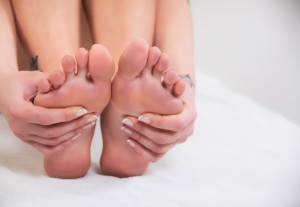 The term “shin splints” refers to pain along the shin bone in the lower leg that is caused by overuse. They are a common problem among athletes and people who regularly engage in activities, such as as running or jogging, that put stress on their lower limbs. Fortunately, pain from shin splints can be prevented and alleviated by stretching your legs. One simple stretch that you can do is toe curls. You can do this stretch by sitting on a chair with a towel spread out on the floor in front of you. Put your feet on the towel, and using just your toes, grab the towel and lift it up. Toe curls and many other stretches can improve the flexibility and strength of the muscles and tendons in the lower legs. If you suffer from shin splints and find that your pain is severe, chronic, or interferes with your daily activities, don’t hesitate to schedule an appointment with a podiatrist near you.
The term “shin splints” refers to pain along the shin bone in the lower leg that is caused by overuse. They are a common problem among athletes and people who regularly engage in activities, such as as running or jogging, that put stress on their lower limbs. Fortunately, pain from shin splints can be prevented and alleviated by stretching your legs. One simple stretch that you can do is toe curls. You can do this stretch by sitting on a chair with a towel spread out on the floor in front of you. Put your feet on the towel, and using just your toes, grab the towel and lift it up. Toe curls and many other stretches can improve the flexibility and strength of the muscles and tendons in the lower legs. If you suffer from shin splints and find that your pain is severe, chronic, or interferes with your daily activities, don’t hesitate to schedule an appointment with a podiatrist near you.
Exercising your feet regularly with the proper foot wear is a great way to prevent injuries and build strength. If you have any concerns about your feet, contact Dr. Michael D. Garvin from Florida. Our doctor can provide the care you need to keep you pain-free and on your feet.
Exercise for Your Feet
Exercise for your feet can help you gain strength, mobility and flexibility in your feet. They say that strengthening your feet can be just as rewarding as strengthening another part of the body. Your feet are very important, and we often forget about them in our daily tasks. But it is because of our feet that are we able to get going and do what we need to. For those of us fortunate enough to not have any foot problems, it is an important gesture to take care of them to ensure good health in the long run.
Some foot health exercises can include ankle pumps, tip-toeing, toe rises, lifting off the floor doing reps and sets, and flexing the toes. It is best to speak with Our doctor to determine an appropriate regimen for your needs. Everyone’s needs and bodies are different, and the activities required to maintain strength in the feet vary from individual to individual.
Once you get into a routine of doing regular exercise, you may notice a difference in your feet and how strong they may become.
If you have any questions please feel free to contact our offices located in Port St. Lucie, FL . We offer the newest diagnostic and treatment technologies for all your foot and ankle needs.
More...
Tarsal Tunnel Syndrome
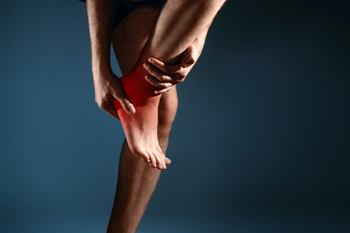
The tarsal tunnel is a narrow space that lies inside the ankle, next to the ankle bones. The tunnel is covered by a thick ligament that protects the arteries, veins, tendons, and nerves in the tunnel. The posterior tibial nerve within the tunnel is the focus of tarsal tunnel syndrome because it is the compression or squeezing of this nerve that produces symptoms along the path of the nerve running from the inside of the ankle into the foot. This condition is similar to carpal tunnel syndrome, which occurs in the wrist. Both arise from the compression of a nerve in a confined space. Those with flat feet, varicose veins, ankle sprains, or arthritis are more at risk for developing tarsal tunnel syndrome since these things can compress the nerve. When one has this syndrome, they might experience tingling or burning sensations, numbness, and/or pain on the inside of the ankle or on the bottom of the foot. These symptoms can also extend to the heel, arch, toes, and even calf. They are often brought on by overuse of the foot. It is important to seek treatment before permanent nerve damage results. If you think you may have tarsal tunnel syndrome or pain that resembles these symptoms, see a podiatrist as soon as possible for diagnosis and treatment that is right for you.
Tarsal tunnel syndrome can be very uncomfortable to live with. If you are experiencing tarsal tunnel syndrome, contact Dr. Michael D. Garvin of Florida. Our doctor can provide the care you need to keep you pain-free and on your feet.
Tarsal Tunnel Syndrome
Tarsal tunnel syndrome, which can also be called tibial nerve dysfunction, is an uncommon condition of misfiring peripheral nerves in the foot. The tibial nerve is the peripheral nerve in the leg responsible for sensation and movement of the foot and calf muscles. In tarsal tunnel syndrome, the tibial nerve is damaged, causing problems with movement and feeling in the foot of the affected leg.
Common Cause of Tarsal Tunnel Syndrome
- Involves pressure or an injury, direct pressure on the tibial nerve for an extended period of time, sometimes caused by other body structures close by or near the knee.
- Diseases that damage nerves, including diabetes, may cause tarsal tunnel syndrome.
- At times, tarsal tunnel syndrome can appear without an obvious cause in some cases.
The Effects of Tarsal Tunnel Syndrome
- Different sensations, an afflicted person may experience pain, tingling, burning or other unusual sensations in the foot of the affected leg.
- The foot muscles, toes and ankle become weaker, and curling your toes or flexing your foot can become difficult.
- If condition worsens, infections and ulcers may develop on the foot that is experiencing the syndrome.
A physical exam of the leg can help identify the presence of tarsal tunnel syndrome. Medical tests, such as a nerve biopsy, are also used to diagnose the condition. Patients may receive physical therapy and prescriptive medication. In extreme cases, some may require surgery.
If you have any questions please feel free to contact our offices located in Port St. Lucie, FL . We offer the newest diagnostic and treatment technologies for all your foot and ankle needs.
Various Reasons Why Feet Can Become Swollen

Excessive fluid in the feet can cause extreme swelling. This is an uncomfortable feeling, and is known as edema. Some of the symptoms that can accompany swollen feet include bruising, numbness, and the feet may feel stiff. When the feet become swollen, it may be indicative of existing medical conditions, which include arthritis. Additionally, it may happen as a result of an ankle sprain or fracture, and this typically happens immediately. The feet may become swollen from an insect bite, and this is considered to be an allergic reaction. Some people notice their feet can become swollen from standing for extended periods of time throughout the day, and can be very common among pregnant women. The warmer temperatures may cause the feet to become swollen, and it is suggested that sodium intake is reduced. If your feet are swollen, please schedule an appointment with a podiatrist who can effectively determine what the cause is, and offer correct treatment options.
Swollen feet can be a sign of an underlying condition. If you have any concerns, contact Dr. Michael D. Garvin of Florida. Our doctor can provide the care you need to keep you pain-free and on your feet.
Swollen feet are a common ailment among pregnant women and people who stand or sit for extended periods. Aging may increase the possibility of swollen feet and patients who are obese often notice when their feet are swelling too. There may be medical reasons why swollen feet occur:
- Phlebitis - A condition that causes the veins to become inflamed and can also cause leg pain.
- Liver disease - This may lead to low blood levels of albumin which is a protein. This can cause fluid in the blood to pass into the tissues and several areas of the body can become swollen.
- Heart failure - When the heart doesn’t pump properly the blood that is normally pumped back to the heart can pool in the veins of the legs causing swollen feet.
- Kidney disease - One of the main functions of the kidneys is releasing excess fluid in the body. This type of condition can make it difficult for the kidneys to function properly, and as a result the feet may become swollen.
- Deep-vein thrombosis (DVT)- This is a serious condition where blood clots form in the veins of the legs. They can block the return of blood from the legs to the heart which may cause the feet to swell. It is important to be treated by a podiatrist if this condition is present.
Swollen feet can also be caused by bone and tendon conditions, including fractures, arthritis, and tendinitis. Additionally, there may be skin and toenail conditions and an infection may cause the feet to swell. Patients who take medicine to treat high blood pressure may be prone to getting swollen feet.
Many patients elevate their feet to help relieve the swelling and this is generally a temporary remedy. When a podiatrist is consulted the reason behind the swelling can be uncovered and subsequently treated.
If you have any questions please feel free to contact our offices located in Port St. Lucie, FL . We offer the newest diagnostic tools and technology to treat your foot and ankle needs.
How Orthotics Help Your Feet
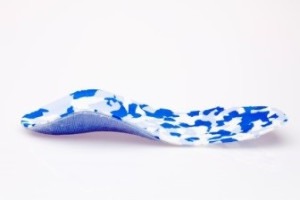 Your feet have the potential to impact nearly every part of your body. If there is a problem with them, the effects can range from minor to extremely serious. Orthotics can solve some of the most common issues you may have with you feet. Overpronation is when the foot leans inward, causing an uneven distribution of weight as you walk. Underpronation is just the opposite. This occurs when your foot leans to the outside. Improper distribution of weight results here as well. Both of these conditions can be improved by wearing properly fitted orthotics. The orthotics promote alignment by supporting the arch, absorbing shock, and essentially controlling how the foot hits the ground.
Your feet have the potential to impact nearly every part of your body. If there is a problem with them, the effects can range from minor to extremely serious. Orthotics can solve some of the most common issues you may have with you feet. Overpronation is when the foot leans inward, causing an uneven distribution of weight as you walk. Underpronation is just the opposite. This occurs when your foot leans to the outside. Improper distribution of weight results here as well. Both of these conditions can be improved by wearing properly fitted orthotics. The orthotics promote alignment by supporting the arch, absorbing shock, and essentially controlling how the foot hits the ground.
If you are having discomfort in your feet and would like to try orthotics, contact Dr. Michael D. Garvin from Florida. Our doctor can provide the care you need to keep you pain-free and on your feet.
What Are Orthotics?
Orthotics are inserts you can place into your shoes to help with a variety of foot problems such as flat feet or foot pain. Orthotics provide relief and comfort for minor foot and heel pain but can’t correct serious biomechanical problems in your feet.
Over-the-Counter Inserts
Orthotics come in a wide variety of over-the-counter inserts that are used to treat foot pain, heel pain, and minor problems. For example, arch supports can be inserted into your shoes to help correct overarched or flat feet, while gel insoles are often used because they provide comfort and relief from foot and heel pain by alleviating pressure.
Prescription Orthotics
If over-the-counter inserts don’t work for you or if you have a more severe foot concern, it is possible to have your podiatrist prescribe custom orthotics. These high-quality inserts are designed to treat problems such as abnormal motion, plantar fasciitis, and severe forms of heel pain. They can even be used to help patients suffering from diabetes by treating foot ulcers and painful calluses and are usually molded to your feet individually, which allows them to provide full support and comfort.
If you are experiencing minor to severe foot or heel pain, it’s recommended to speak with your podiatrist about the possibilities of using orthotics. A podiatrist can determine which type of orthotic is right for you and allow you to take the first steps towards being pain-free.
If you have any questions please contact our offices located in Port St. Lucie, FL . We offer the newest diagnostic and treatment technologies for all your foot and ankle needs.
Morton's Neuroma: Explained
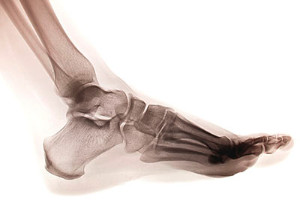 Morton’s Neuroma, caused by a thickening of tissue around the nerves in your toes, usually happens between the third and fourth toes, causing a feeling like something is stuck in your sock. Your foot, which has more than 100 muscles, 26 bones, and 33 joints, is a very complex structure, and is why foot pain can be so common. Morton’s Neuroma is often treated fairly simply, by things like foot and arch supports, anti-inflammatories, orthotics, and physical therapy. It is always important to discuss with your doctor the best treatment plan that is right for you. This condition must be treated, to ensure that no additional foot complications develop over time.
Morton’s Neuroma, caused by a thickening of tissue around the nerves in your toes, usually happens between the third and fourth toes, causing a feeling like something is stuck in your sock. Your foot, which has more than 100 muscles, 26 bones, and 33 joints, is a very complex structure, and is why foot pain can be so common. Morton’s Neuroma is often treated fairly simply, by things like foot and arch supports, anti-inflammatories, orthotics, and physical therapy. It is always important to discuss with your doctor the best treatment plan that is right for you. This condition must be treated, to ensure that no additional foot complications develop over time.
Morton’s neuroma is a very uncomfortable condition to live with. If you think you have Morton’s neuroma, contact Dr. Michael D. Garvin of Florida. Our doctor will attend to all of your foot care needs and answer any of your related questions.
Morton’s Neuroma
Morton's neuroma is a painful foot condition that commonly affects the areas between the second and third or third and fourth toe, although other areas of the foot are also susceptible. Morton’s neuroma is caused by an inflamed nerve in the foot that is being squeezed and aggravated by surrounding bones.
What Increases the Chances of Having Morton’s Neuroma?
- Ill-fitting high heels or shoes that add pressure to the toe or foot
- Jogging, running or any sport that involves constant impact to the foot
- Flat feet, bunions, and any other foot deformities
Morton’s neuroma is a very treatable condition. Orthotics and shoe inserts can often be used to alleviate the pain on the forefront of the feet. In more severe cases, corticosteroids can also be prescribed. In order to figure out the best treatment for your neuroma, it’s recommended to seek the care of a podiatrist who can diagnose your condition and provide different treatment options.
If you have any questions, please feel free to contact our offices located in Port St. Lucie, FL . We offer the newest diagnostic and treatment technologies for all your foot care needs.
